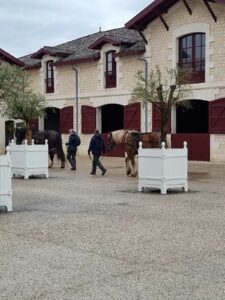I am currently sitting, slightly jaded from a full week of claret tasting, wearing a Pichon Baron polo shirt (paid for with my own money – we are totally incorruptible at L&S…) and thinking about what I can pen to give you the greatest insight possible into the 2023 vintage.
As luck would have it, I managed to sit next to a courtier on the plane home (he was on the way to Mexico for a holiday, with his girlfriend). Courtiers are the middlemen who work between the Châteaux and the négociants (also known collectively as the ‘Place de Bordeaux’, from whom merchants in each country buy the wines). We rarely see hide nor hair of the courtiers, but they usually have their fingers on the pulse of Bordeaux.
His sentiment was that the releases this vintage will be somewhere between 25 and 40% under those of 2022, depending on the Château. This was largely echoed by négociants and Châteaux during our trip – 2023 has been a good harvest and they want to sell wine, so first and foremost, we should be in for a crop of well to exceptionally well-priced releases.
But will these releases be any good?
One of the first pieces of commentary we heard when arriving on Bordeaux was that 2023 was a ‘rich man’s vintage’. The three major factors which impacted the vintage were the mildew, the yield and the picking time, all three of which cost a lot of money to keep under control.
To look at the first, mildew. 2023 was the wettest vintage in Bordeaux for 25 years, but it was also the second warmest in 25 years (I have some pretty dull charts displaying all this data, if you want to geek out with me, don’t be afraid to ask!). The result of this warm & wet was mildew, (both downy and powdery, that latter a.k.a. ‘oidium’). To fight this, especially if you are biodynamic/low intervention, took a huge amount of work – teams of people working around the clock administering treatments to vines to keep them healthy. This was the first expense to test the depth of the producers’ pockets.
It also spawned an interesting caveat, which is that 2023 is a Cabernet vintage (both Sauvignon and Franc). This is a sweeping statement which is just about as true as sweeping statements can be – you will find that most wines have a higher-than-normal percentage of both of these grapes. Was it because the Cabernet was especially good? In part. Was it because the Merlot was particularly awful? No, not really – it mostly came down to a fact of terroir. Merlot likes clay, clay holds moisture, moisture produces mildew. Sadly, Merlot’s natural habitat caused its downfall, but the Merlot which survived can be very fine indeed.
To look at the second, after that detour. Yield. It’s no secret to you that 2023 was a high yielding vintage, almost ubiquitously. Some Châteaux, particularly on the left bank, nearly hit the legal maximum of 55hl/h (I think 53 was the biggest we heard). It’s an extrapolation, but even I can attest, with my tiny UK vineyard, at how big the crop was in 2023. Vines were positively laden with fruit. The issue then is quality – if you leave too much fruit on a vine (these high yields are very appealing, as any farmer will tell you, when looking at the bottom line) and it doesn’t get enough sun, you will end up with a dilute wine, lacking intensity and brimming with hard tannins. Green harvesting was thus largely practiced among quality conscious estates – dropping fruit before it begins to ripen, to allow the vine to focus on the fewer remaining bunches. This was the second expense to test the Chateau. Fewer bunches mean fewer bottles, so it wasn’t an option for estate with a bottom line to hit.
Finally, the third expense. If you think back to September last year in the UK, it was a particularly fine month, especially in the context of the dreadful summer we went through. In Bordeaux, this pattern was much the same – September sunshine meant that the Châteaux could pick at a leisurely pace, ensuring perfect physical and phenolic ripeness in their grapes. The consideration here, however, was various plots of vines and sometimes even various bunches on vines, were ripening at different rates. This meant that you needed a full picking team on retainer for somewhere up to a month to make a completely thorough go of it. If you are well-heeled enough to be able to employ a full-time picking team, this is a breeze, but if you rely on an itinerant workforce who charge by the day and will go to the highest bidder… you can picture how this would add up to a huge expense, as well as a sub-optimal process for catching your grapes at their finest hour.
Phew. So, unless you were very lucky, you needed a lot of cash to make 2023 a success. So, you might ask, what’s the point if I can’t afford a 1st growth? A good question, but Bordeaux is unique in that many properties are owned as ‘passion projects’ or are legacy holdings of prominent families who have had the freeholds for a very long time. This means that the axiom doesn’t just hold to the most expensive wine being the most finely crafted – take, for example, Château Lagrange. The Japanese owner, Suntory, are happy to throw money at it with no regard for the bottom line, in a bid to build something special. Pedesclaux, Lillian Ladouys and Lafon Rochet are all owned by a multi billionaire who is trying to develop them into exceptional estates, with total disregard for cost. Léoville & Langoa Barton, on the other side of the coin, have been in the family for almost 200 years.
None of these estates are producing especially expensive wine, but they absolutely had the resources to achieve something special in 2023.
 So what sort of wine style did this very peculiar vintage produce?
So what sort of wine style did this very peculiar vintage produce?
The most common comparison we heard was to 2019, with some producers referencing 2001 as a benchmark and one particularly fatuous Château saying it was like 1755.
The best wines are delicious. They have that wonderfully forward, fresh, crunchy fruit which invites you back for another glass, as well as finely sculpted, persistent tannins and some really fresh acidity. I walked away thinking that the vintage created a fascinating counter to 2022. For this vintage, the worse performing estates were in danger of over ripeness, over extraction and overly high alcohol. In 2023, the danger was a lack of density, hard tannins and too much phenolic bitterness. It was labelled by one Château as ‘back to the future’, as it felt like tasting ‘normal claret’ again, after a succession of hot, or obscure seasons.
Perhaps the most exciting thing about 2023 is its ability to translate terroir. The Margaux were very Margaux – pretty, perfumed. The Pomerols were very Pomerol – decadent, hedonistic. The Pauillacs were very Pauillac – powerful, poised. So on and so forth. In 2023, you will not need to be a top blind taster to guess what it is in your glass, the wine will simply tell you.
I have walked away from this vintage, brimming with interest. Highly expressive, terroir focussed wine, at a potential 40% discount? It feels like Bordeaux is back.
Releases will begin on Monday, with Château Batailley and are expected to progress rapidly from there, so please do express your interest as soon as possible. If you would like to learn more, then by all means call me. It’s a fascinating vintage to chat about.

In summary:
- The most successful Châteaux were the most well-resourced, due to labour intensive vintage.
- The good wines are very expressive, terroir focussed and classic (13% alcohol for many).
- The not so good wines are underripe, have hard tannins and lack concentration.
- Stylistically 2019 was the most common vintage comparison
- Potentially priced between 25-40% lower than 2022
- A very strong Cabernet vintage